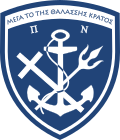 HS Roussen, P-67 in Piraeus during Saint Nicholas festival of 2009. | |
| Class overview | |
|---|---|
| Name | Roussen, Super Vita |
| Builders | |
| Operators | |
| Preceded by | La Combattante IIIb |
| In commission | 2005 - present day |
| Planned | 7 |
| Completed | 7 |
| Active | 7 |
| General characteristics | |
| Type | FACM |
| Displacement | 580 tons / 668 tons fully loaded |
| Length | 62 m |
| Beam | 9.5 m |
| Draught | 2.6 m |
| Propulsion | 4 × MTU 16V595 TE90 diesel engines 23,500 hp |
| Speed | 35 knots (65 km/h; 40 mph) |
| Complement | 45 |
| Sensors & processing systems | |
| Electronic warfare & decoys |
|
| Armament |
|
The Roussen class [1] is a seven-strong class of British-designed fast attack missile boats improved and customized for the Hellenic Navy, also known as Super Vita. The class is named after its lead ship, which in turn is named after Lt Nikolaos Roussen, a World War II submarines officer who was killed in the suppression of the Navy mutiny in April 1944.


